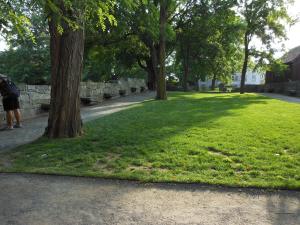As a librarian who can’t quite leave it all behind, my vacations usually include at least one visit to at least one of the following: Historic sites, museums, libraries or archives. But since I live in southwest Ohio and have family in upstate New York and New England, going on vacation often also involves stopping to see various relatives.
This summer’s trip East had the added complication of a five-day [non-work-related] convention in Boston. Thus there was not much time for sightseeing, with most time spent among the living.

However, while staying with my brother in southern New Hampshire, I managed to squeeze in an afternoon trip to one site I had not visited before–Salem, Massachusetts. Yes, the town associated with the witchcraft trials of 1692. I have a personal interest in this place because one of my ancestors was imprisoned and later released during the hysteria, and several other early relatives were involved in the trials. [The actual archives of the trials are in Virginia so I was not able to visit them on this trip.]
Having been forewarned by my brother and nephew that some, well, most “attractions” in Salem are really “tourist traps,” I did a little research and identified several sites that have some actual historical value. My nephew did recommend the “Witch Dungeon,” which is not a museum per se but features a brief re-enactment of part of one of the trials based on actual transcripts, plus a recreated “dungeon” area said to replicate the facilities where the accused were incarcerated. After seeing the tiny cubicles where some prisoners were held, I could better understand why my ancestor was willing to make a false confession to get out of jail.
Walking toward the village’s waterfront, I passed Nathaniel Hawthorne’s “House of the Seven Gables” as well as the Custom House where he worked for a time. Also worth visiting are the Salem Witch Trials Memorial, which honors the twenty people executed for witchcraft [nineteen hanged; one, Giles Corey, pressed to death]; and the old burying ground. The town itself appears to have many early preserved structures, with narrow streets that make access and parking difficult but evoke a time when modern transportation was not imagined.
If you or a patron are planning a research trip to eastern Massachusetts with very limited sightseeing time, that time might be better spent on the Freedom Trail in Boston or at Plimoth Plantation. Still, Salem is well worth visiting if one is interested in this important [albeit dark] chapter of our history.
An interpretive sign at the memorial refers to the Salem Award for Human Rights and Social Justice, which has been presented annually since 1992. To me, this is a fitting place to end a visit to Salem, for the award is given to “an individual or organization that speaks out and takes action for human rights and social justice.”

Leave a comment